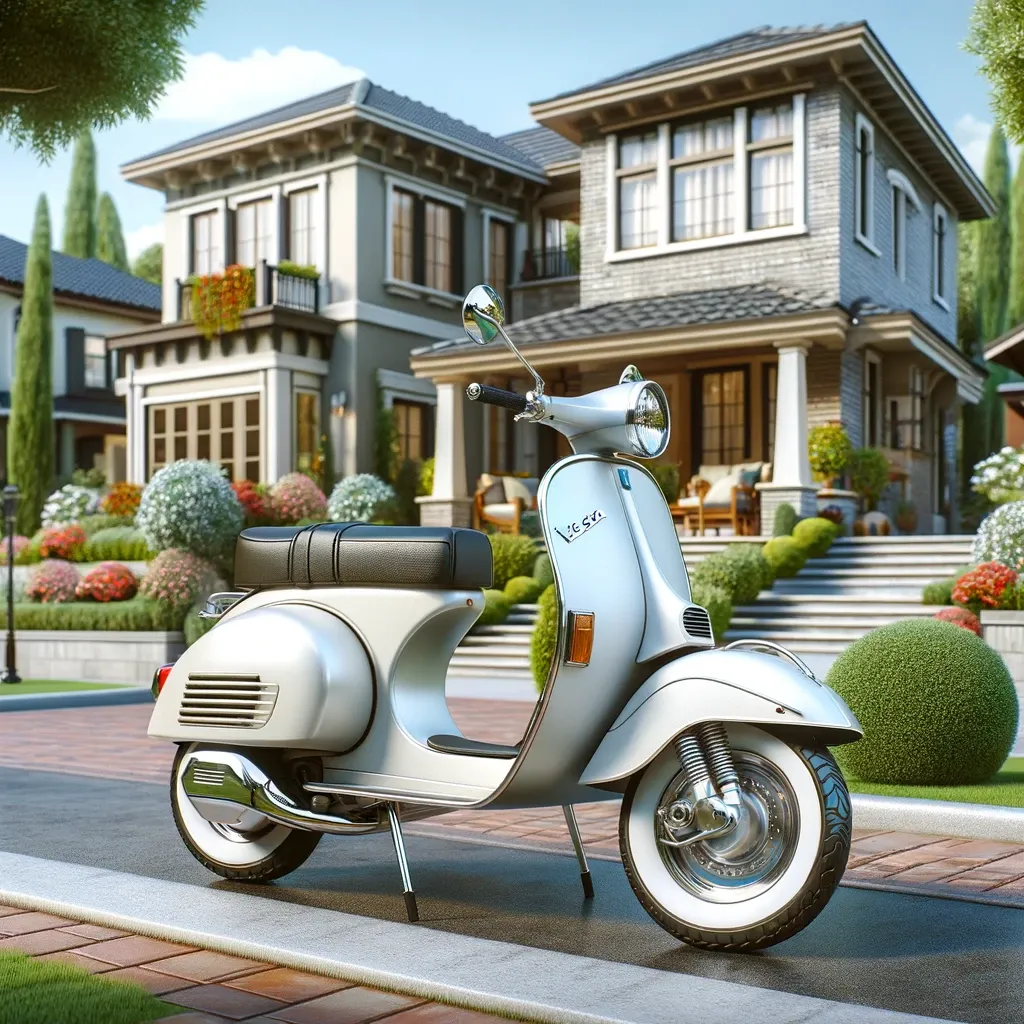Vespa, the iconic Italian scooter, is recognized worldwide for its sleek design and practicality. Born from the ruins of post-World War II Italy, Vespa offered a practical transportation solution amidst the country's economic turmoil. Its stylish, wasp-like design quickly captured Italian hearts, symbolizing freedom and modernity. This blend of utility and charm helped Vespa transcend its origins, becoming an international sensation. Key appearances in popular culture, such as Audrey Hepburn's ride in "Roman Holiday," solidified its status as a cultural icon. Today, Vespa remains a beloved symbol of style and innovation globally.
Post-War Italy's Devastation
By the end of World War II, Italy was a landscape of destruction and despair. The country had surrendered to the Allies in 1943, only to be immediately occupied by German forces. Over the next two years, Italy became a battleground, with fierce fighting that devastated cities and the countryside alike. The toll was immense: hundreds of thousands of lives were lost, and the nation's infrastructure was left in ruins.
Bombing campaigns had obliterated roads, bridges, and factories, plunging Italy into massive debt and economic hardship. The government's inability to rebuild and recover was starkly apparent. Unlike the industrialized Allied countries, which could afford to transition from wartime production back to civilian manufacturing, Italy was financially crippled. Its automotive factories, once converted to produce military equipment, were now idle, and there were no resources to revert them to their original purpose.
In 1946, Italy's government was too weak and too indebted to provide the necessary support for industrial revival. The dire economic conditions forced Italian industrialists to find innovative solutions with the limited resources at their disposal. They had to adapt quickly to survive in a landscape that offered little support.
One such industrialist was Enrico Piaggio, who faced the enormous challenge of restarting his family's business. Before the war, the Piaggio company had been known for producing locomotives and train cars. However, during the war, their factory had been converted to manufacture military aircraft, making it a prime target for Allied bombings. By the end of the war, the Piaggio factory was nothing more than a pile of rubble.
With his factory destroyed and no funds to rebuild a complex production line for trains or aircraft, Enrico Piaggio had to rethink his approach. He needed a product that was affordable to produce and could meet the immediate needs of a war-torn nation. This was the challenging environment in which the Vespa was conceived—a product born out of necessity and resilience, set against the backdrop of a devastated Italy.
The Challenge of Recovery
In the immediate aftermath of World War II, Italy faced an uphill battle to recover. The nation’s economy was in shambles, its infrastructure decimated. While other countries began focusing on consumer goods, Italy struggled to transition from wartime production. Automotive factories, repurposed for military manufacturing during the conflict, stood idle due to a lack of funds and resources to convert back to peacetime production.
This economic paralysis left Italian industrialists in a bind. Without government support or repaired infrastructure, they had to innovate with what little they had. The challenge was to create products that were affordable to produce and vital for everyday life. The dire state of the roads and the general scarcity of resources necessitated a practical solution that could withstand the harsh conditions of post-war Italy.
In this bleak context, Enrico Piaggio, head of the Piaggio company, saw an opportunity. Realizing the impossibility of rebuilding his aircraft factory, he pivoted towards a different kind of transportation. He envisioned a vehicle that was not only practical and affordable but also capable of navigating Italy’s bomb-ravaged streets. This vision set the stage for the creation of the Vespa, a scooter designed to meet the needs of a nation in recovery.
Enrico Piaggio's Vision
Amidst the rubble of post-war Italy, Enrico Piaggio stood at a crossroads. His family's company, once a proud producer of locomotives and train cars, had pivoted to aircraft production during the war, making it a target for Allied bombings. With the factory destroyed and funds depleted, Enrico needed a new direction.
Enrico understood the dire need for affordable, reliable transportation. Italy's infrastructure was in ruins, making traditional cars impractical for most people. The solution had to be something different—something capable of navigating the bombed-out streets while being cost-effective to produce.
Drawing inspiration from the small, utilitarian scooters used by American soldiers during the war, Enrico envisioned a vehicle that was both sturdy and versatile. But he didn't just want to create a functional scooter; he aimed to design something stylish and modern that would inspire a sense of pride and hope in the Italian people.
To realize this vision, Enrico tapped into the pool of talented engineers left jobless by the post-war ban on military technology development. He recruited Corradino D'Ascanio, a brilliant aeronautical engineer, to bring his concept to life. Together, they set out to create a scooter that would become an enduring symbol of Italian innovation and resilience: the Vespa.
Inspiration from the Battlefield
Enrico Piaggio found unexpected inspiration for his new transportation project from the battlefields of World War II. During the war, American soldiers used Cushman scooters to navigate quickly around bases and even in combat zones. These scooters were practical for rough terrains and tight spaces, making them ideal for military use. However, they were designed with functionality in mind, lacking comfort, driver protection, and aesthetic appeal.
Enrico saw the potential in these utilitarian vehicles. He envisioned a civilian version that was not only practical but also comfortable and stylish. The challenge was to transform the rugged, no-frills military scooter into something appealing for everyday use. This vision required more than just technical modifications; it needed a complete redesign that combined form and function.
To achieve this, Enrico leveraged the expertise of Corradino D'Ascanio, a skilled aeronautical engineer. D'Ascanio applied principles from aircraft engineering to develop a scooter that was lightweight yet sturdy, with a design that protected the driver from dirt and debris. The result was a scooter that was easy to handle, reliable, and visually striking.
This innovative approach marked the birth of the Vespa, a scooter that would soon captivate Italy and the world with its unique blend of practicality and style.
Engineering Ingenuity
With the collaboration of Corradino D'Ascanio, a talented aeronautical engineer, Enrico Piaggio's vision began to take shape. D'Ascanio brought a fresh perspective, applying principles from aircraft design to overcome the inherent challenges of creating a durable, lightweight scooter. His innovative approach ensured that the new vehicle would be both practical and stylish.
One of D'Ascanio’s key innovations was designing a body that protected the driver from dirt and debris—a significant improvement over the exposed, rugged military scooters. He also concealed the engine, keeping oil, grease, and grime away from the rider, enhancing both cleanliness and safety. These features made the Vespa not just a mode of transport, but a comfortable and reliable choice for everyday use.
D'Ascanio's aeronautical background proved invaluable in addressing the technical challenges. He designed a sturdy frame that could handle the bombed-out roads of post-war Italy while remaining easy to maneuver. The scooter's lightweight construction and efficient engine made it affordable to produce and operate, which was crucial in a country facing economic hardship.
The result was a prototype that was both functional and aesthetically pleasing. When Enrico Piaggio first saw the prototype, he was struck by its design, famously remarking that it looked like a wasp—"Vespa" in Italian. This marked the birth of a scooter that would soon become an icon of Italian ingenuity and design, setting the stage for its widespread success.
The Birth of Vespa
The prototype scooter created by Corradino D'Ascanio embodied everything Enrico Piaggio had envisioned. Its sleek, wasp-like design (hence the name "Vespa") featured a wide central piece and a steering rod that resembled antennas. This innovative design combined with practical functionality made the Vespa a perfect fit for post-war Italy's needs.
Production of the Vespa began in the spring of 1946. The initial run of 2,500 units was a cautious start, reflecting the uncertain economic climate. However, the scooter quickly proved its worth, offering Italians a reliable, stylish, and affordable means of transportation. Its ease of use and maintenance further enhanced its appeal, making it accessible to a broad audience.
The first year's success was a testament to Piaggio's vision and D'Ascanio's engineering prowess. Enrico wisely reinvested the profits into expanding the factory, ramping up production to meet the growing demand. By the following year, sales had quadrupled to 10,000 units, and by the end of the decade, the figure had skyrocketed to 60,000.
The Vespa wasn't just a vehicle; it was a symbol of Italy's post-war recovery and a beacon of hope. It became a part of everyday life, helping to rebuild the country's mobility and economy, while also capturing the imaginations of people worldwide.
Vespa's Rapid Growth
As Vespa production ramped up, its popularity soared both in Italy and abroad. The scooter’s blend of practicality, style, and affordability made it an instant hit. By 1948, Vespa was not only a staple on Italian streets but also gaining traction internationally. Enrico Piaggio strategically expanded into foreign markets, recognizing the universal appeal of the Vespa.
One of the first major international successes was in India, where Vespa became the country’s first scooter brand. This expansion laid the groundwork for a near-monopoly that would last for decades. The Vespa’s design was perfectly suited for the crowded, bustling cities of India, just as it was for Italy's post-war urban landscape.
In 1953, the Vespa’s fame received a monumental boost with the release of the film "Roman Holiday." Audrey Hepburn’s iconic ride through Rome on a Vespa captured the hearts of moviegoers worldwide. The film showcased the scooter's elegance and functionality, sparking a surge in demand. It’s estimated that over 100,000 Vespas were sold as a direct result of the film’s popularity.
By the late 1950s, Vespa had become more than just a scooter; it was a cultural phenomenon. It symbolized freedom, modernity, and Italian craftsmanship. Its influence extended beyond transportation, impacting fashion, film, and even language, as the term "vespare" (to go somewhere on a Vespa) entered the Italian lexicon. The Vespa had firmly established itself as an enduring icon of post-war innovation and style.
Cultural Impact
The Vespa’s cultural impact extended far beyond transportation. It quickly became a symbol of Italian style and sophistication, embodying a sense of freedom and modernity that resonated worldwide. The scooter's sleek design and practical appeal caught the attention of fashion and entertainment industries, propelling it into the global spotlight.
One of the most notable cultural influences of the Vespa was its role in the Mod subculture in London during the late 1950s and 1960s. Mods, characterized by their stylish attire and love for modern jazz, adopted the Vespa as their preferred mode of transportation. The scooter’s affordability, ease of customization, and chic design made it an ideal fit for this youth movement, which emphasized individuality and fashion.
The Vespa also became a symbol of romance and adventure, thanks in part to its prominent appearance in "Roman Holiday." Audrey Hepburn and Gregory Peck riding through Rome on a Vespa captured the imaginations of audiences worldwide, creating a lasting association between the scooter and the allure of travel and exploration.
Additionally, Vespa's influence permeated popular media, from movies to advertisements, cementing its status as an icon. It wasn’t just a vehicle; it represented a lifestyle—a blend of practicality and elegance that appealed to a broad spectrum of society. This cultural significance helped the Vespa maintain its popularity and iconic status through the decades, continually adapting to new trends while preserving its classic appeal.
Enduring Legacy
The Vespa's journey from a post-war necessity to a global cultural icon is a testament to the power of innovation, resilience, and timeless design. Over the decades, Vespa has remained relevant by continually adapting to changing tastes and technologies while preserving the essence of its original charm.
Today, Vespa is celebrated not just as a scooter but as a symbol of freedom, style, and Italian ingenuity. Its classic design has evolved, incorporating modern features like advanced engines and eco-friendly technologies, yet it still retains the distinctive look that first captured the world’s attention.
Vespa's enduring legacy is also reflected in its presence across various aspects of popular culture. It remains a favorite in movies, fashion, and art, symbolizing a sense of carefree sophistication and adventure. Collectors and enthusiasts around the world restore and cherish vintage Vespas, keeping the spirit of its early days alive.
Moreover, Vespa continues to inspire new generations of riders with its blend of practicality and elegance. It represents more than just a mode of transport; it embodies a lifestyle choice that values beauty, efficiency, and a touch of nostalgia. Enrico Piaggio’s vision has indeed stood the test of time, proving that good design and ingenuity can turn a simple idea into an everlasting icon.






